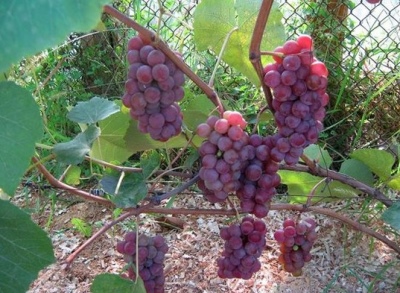
- Authors: USA
- Appointment: universal
- Berry color: pink
- Taste: sweet with sourness, with citron-nutmeg aroma
- Ripening period: early
- Ripening period, days: 120
- Frost resistance, ° C: -35
- Name synonyms: Lucile, Lucile, Lucille
- Bunch weight, g: up to 200
- Flower type: bisexual
This variety is versatile. It is used for the preparation of wines, various jams, preserves and other confectionery products, as well as for squeezing juice. It is especially valuable for the preparation of marmalade due to the presence of a large amount of pectin in its composition.
Breeding history
The Lucille grape is a hybrid, one of the parents is the Wyoming variety. First appeared in the USA. In addition to the main one, it also has a name - Lusail.
Geography of distribution
It grows mainly in its homeland, America. But in the Moscow region varieties appeared - full clones of Lucille, they took root well and bear fruit.
Description
The bush has high vigor. The leaf is large in size, on the back side it tends to fluff strongly. Of its distinctive features, one can single out a good ripeness of the vine.
Ripening period
The harvest begins to ripen by the end of summer, it can be harvested in September. Such ripening dates are considered early. The entire bunch of grapes ripens completely. It takes about 120 days from growing season to harvest.
Bunches
Consist of medium sized berries. The clusters themselves are of a fairly dense structure and conical shape. They weigh up to 200 g.
Berries
The fruits of this type are pink in color, with a strong taste and aroma. Slightly oval. The flesh of the berries is slimy, located under the thick skin, which is easy to separate from it. The acidity is quite high, equal to 8-12 g / dm3, but in the presence of 210 g / dm3 sugar, the berries do not have a very sour taste.
Taste
It has a rich taste and strong citron-nutmeg aroma, with a light floral note. Leaves a sour aftertaste. Unfortunately, the wines made from this variety do not retain the natural aroma of its berries.
Yield
Refers to varieties with high yields. It has a good fruiting factor of 2.4-2.7.


Growing features
Doesn't require special conditions. Bears fruit in various climatic zones. Loosening of the soil is necessary, it provides a good exchange of air.
Landing
A universal planting scheme is suitable, which is applied to many varieties of grapes. For planting seedlings, the soil is first loosened and grooves 15-18 cm are made.

Pollination
To grow Lucille, you do not need to plant other grape varieties next to it. It bears fruit well alone and does not need pollen donors. Since it blooms flowers of both sexes, which are well pollinated with each other.
Pruning
Pruning is done after winter to remove dead shoots.Or, within a year, when a disease appears, the bad parts of the plant are removed.



Top dressing
Top dressing is applied only in the second year of the culture's life, when the soil begins to deplete.
For feeding, humus and peat are used, and also rotted manure is introduced immediately after wintering. Fresh manure can burn the root system, so it is not used. Plants are also fertilized with mineral fertilizers.
Frost resistance and the need for shelter
Possesses high frost resistance, tolerates low temperature conditions up to -35 ° С. That allows it to be grown not only in the southern regions. Refers to grape varieties that do not require additional shelter for wintering, which greatly facilitates caring for it and makes it available for cultivation by novice gardeners.

Diseases and pests
Very well resistant to fungal diseases. Therefore, it is required to carry out the usual prophylaxis against powdery mildew and mildew. The plant is treated with a solution of "Fundazol".
From the birds, they build cages around the bushes or wrap the bunches in cloth bags to preserve the berries.

If a grape is exposed to any disease or insect, this always affects its appearance.
Storage
Stores very well and also tolerates transportation well. Therefore, it is an excellent variety for growing for commercial purposes. But there is a small minus that must be taken into account - the berries are prone to cracking.
Lucille is an American grape variety that tolerates cold climates, has good transportability and good taste.











































































